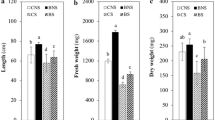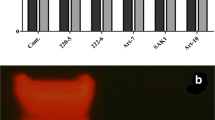Abstract
The higher content of salt in soil is the key constraint to crop productivity. Induction of stress ethylene production from 1-aminocyclopropane-1-carboxylate (ACC) in the plant system is one of the consequences of salt stress responsible for toxicity to the plant. Several transgenic plants have been developed by expressing the ACC deaminase bacterial gene as a stress management strategy which apart from being a costly proposition lacks public acceptability. Our main objective was to investigate if a plant inoculated with ACC-deaminase-producing bacterial endophyte will effectively mitigate salt-induced damage and act as an alternative to transgenics. An ACC deaminase-producing salt-tolerant endophyte SMR20 (Brachybacterium paraconglomeratum) was isolated from the roots of Chlorophytum borivilianum, a medicinal plant sensitive to salt stress. Initially we tested ACC-deaminase-producing SMR20 for amelioration of salt stress-induced damage at three different concentrations of salt, that is, 0, 75, 100 and 150 mM NaCl. 150 mM salt stress was selected for further study because wider differences between inoculated and uninoculated plants were noticed under this concentration of NaCl stress. Inoculated with SMR20 successfully protected C. borivilianum from salt stress-induced crop losses. SMR20 significantly alleviated the negative impact of salinity by potential deamination of ACC (precursor for ethylene generation) in the host Chlorophytum roots leading to decreased production of stress ethylene, delayed chlorosis and senescence that resulted in improved yield of plants. Apart from reducing stress ethylene, the presence of the endophyte also affected other phytohormone quantities like indole-3-acetic acid and abscisic acid in plants. It also altered the amount of total leaf pigments and biochemical compounds like proline, malondialdehyde and enhanced foliar nutrient uptake. Due to these outcomes, it appears that an ACC-deaminase-producing endophyte can enhance crop tolerance against salinity stress and can be an important area to explore.






Similar content being viewed by others
References
Abbas W, Ashraf M, Akram NA (2010) Alleviation of salt induced adverse effects in eggplant (Solanum melongena L.) by glycine betaine and sugar beet extracts. Sci Hortic 125:188–195
Abeles FB, Morgan PW, Saltveit ME Jr (1992) Ethylene in plant biology, 2nd edn. Academic Press, San Diego
Albacete A, Ghanem ME, Martínez-Andújar C, Acosta M, Sánchez-Bravo J, Martínez V, Lutts S, Dodd IC, Pérez-Alfocea F (2008) Hormonal changes in relation to biomass partitioning and shoot growth impairment in salinized tomato (Solanum lycopersicum L.) plants. J Exp Bot 59:4119–4131
Ali S, Charles TC, Glick BR (2014) Amelioration of high salinity stress damage by plant growth-promoting bacterial endophytes that contain ACC deaminase. Plant Physiol Biochem 80:160–167
Awasthi A, Bharti N, Nair P, Singh R, Shukla AK, Gupta MM, Darokar MP, Kalra A (2011) Synergistic effect of Glomus mosseae and nitrogen fixing Bacillus subtilis strain Daz26 on artemisinin content in Artemisia annua L. Appl Soil Ecol 49:125–130
Barnawal D, Bharti N, Maji D, Chanotiya CS, Kalra A (2012) 1-Aminocyclopropane-1-carboxylic acid (ACC) deaminase-containing rhizobacteria protect Ocimum sanctum plants during waterlogging stress via reduced ethylene generation. Plant Physiol Biochem 58:227–235
Barnawal D, Bharti N, Maji D, Chanotiya CS, Kalra A (2014) ACC deaminase-containing arthrobacter protophormiae induces NaCl stress tolerance through reduced ACC oxidase activity and ethylene production resulting in improved nodulation and mycorrhization in Pisum sativum. J Plant Physiol 171(11):884–894
Bates LS, Waldern RP, Teare LD (1973) Rapid determination of free proline for water use studies. Plant Soil 39:205–208
Cluis CP, Mouchel CF, Hardtke CS (2004) The Arabidopsis transcription factor HY5 integrates light and hormone signalling pathways. Plant J 38:332–347
Cramer GR (1997) Uptake and role of ions in salt tolerance. In: Jaiwal PK, Singh RP, Gulati A (eds) Strategies for improving salt tolerance in higher plants. Oxford and IBH Publishing Co. Pvt. Ltd., New Delhi, pp 55–86
Dodd IC, Perez-Alfocea F (2012) Microbial amelioration of crop salinity stress. J Exp Bot 63(9):3415–3428
Dodd IC, Zinovkina NY, Safronova VI, Belimov AA (2010) Rhizobacterial mediation of plant hormone status. Ann Appl Biol 157:361–379
Du H, Liu H, Xiong L (2013) Endogenous auxin and jasmonic acid levels are differentially modulated by abiotic stresses in rice. Front Plant Sci 4:397
Feng JN, Barker AV (1992) Ethylene evolution and ammonium accumulation by tomato plants under water and salinity stresses II. J Plant Nutr 15:2471–2490
Fu J, Huang B (2001) Involvement of antioxidants and lipid peroxidation in the adaptation of two cool-season grasses to localized drought stress. Environ Exp Bot 45:105–114
Gamalero E, Berta G, Massa N, Glick BR, Lingua G (2010) Interactions between Pseudomonas putida UW4 and Gigaspora rosea BEG9 and their consequences for the growth of cucumber under salt-stress conditions. J Appl Microbiol 108:236–245
Glick BR (2005) Modulation of plant ethylene levels by the bacterial enzyme ACC deaminase. FEMS Microbiol Lett 251:1–7
Glick BR (2012) Plant growth-promoting bacteria: mechanisms and applications, Hindawi Publishing Corporation, Scientifica
Gunes A, Inal A, Alpaslan M, Eraslan F, Guneri E, Cicek N (2007) Salicylic acid induced changes on some physiological parameters symptomatic for oxidative stress and mineral nutrition in maize (Zea mays L.) grown under salinity. J Plant Physiol 164:728–736
Hallmann J, Berg G, Schez B (2006) Isolation procedure for endophytic microorganisms. In: Schulz B, Boyle C, Sieber TN (eds) Microbial root endophytes, vol 9. Springer, Berlin, pp 299–319
Hardoim PR, van Overbeek LS, Elsas JD (2008) Properties of bacterial endophytes and their proposed role in plant growth. Trends Microbiol 16(10):463–471
Hauser F, Waadt R, Schroeder JI (2011) Evolution of abscisic acid synthesis and signaling mechanisms. Current Biol 21:346–355
Heath RL, Packer L (1968) Photoperoxidation in isolated chloroplasts. I. Kinetics and stoichiometry of fatty acid peroxidation. Arch Biochem Biophys 125:189–198
Irigoyen JJ, Emerich DW, Sánchez-Díaz M (1992) Water stress induced changes in concentrations of proline and total soluble sugars in nodulated alfalfa (Medicago sativa) plants. Physiol Plant 84:67–72
Khan AL, Hamayun M, Kim Y, Kang S, Lee I (2011) Ameliorative symbiosis of endophyte (Penicillium funiculosum LHL06) under salt stress elevated plant growth of Glycine max L. Plant Physiol Biochem 49:852–861
Kurepin LV, Park JM, Lazarovits G, Bernards MA (2015) Burkholderia phytofirmans-induced shoot and root growth promotion is associated with endogenous changes in plant growth hormone levels. Plant Growth Regul 75(1):199–207
Lopez-Climent MF, Arbona V, Perez-Clemente RM, Gomez-Cadenas A (2008) Relationship between salt tolerance and photosynthetic machinery performance in citrus. Environ Exp Bot 62:176–184
Maclachlan S, Zalik S (1963) Plastid structure chlorophyll concentration and free amino acid composition of a chlorophyll mutant. Can J Bot 41:1053–1062
Madhaiyan M, Poonguzhali S, Sa TM (2007) Characterization of 1-aminocyclopropane-1-carboxylate (ACC) deaminase containing Methylobacteriumoryzae and interactions with auxins and ACC regulation of ethylene in canola (Brassica campestris). Planta 226:867–876
Martín-Rodríguez JÁ, León-Morcillo R, Vierheilig H, Ocampo JA, Ludwig-Müller J, García-Garrido JM (2011) Ethylene-dependent/ethylene-independent ABA regulation of tomato plants colonized by arbuscular mycorrhiza fungi. New Phytol 190(1):193–205
Mayak S, Tirosh T, Glick BR (2004) Plant growth-promoting bacteria confer resistance in tomato plants to salt stress. Plant Physiol Biochem 42(6):565–572
Munns R (2002) Comparative physiology of salt and water stress. Plant Cell Environ 25:239–250
Munns R, Tester M (2008) Mechanisms of salinity tolerance. Ann Rev Plant Biol 59:651–681
Nadeem SM, Zahir ZA, Naveed M, Arshad M (2009) Rhizobacteria containing ACC-deaminase confer salt tolerance in maize grown on salt-affected fields. Can J Microbiol 55:1302–1309
Ort DR (2001) When there is too much light. Plant Physiol 125:29–32
Penrose DM, Glick BR (2002) Methods for isolating and characterizing ACC deaminase-containing plant growth promoting rhizobacteria. Physiol Planta 118:10–15
Pérez-Alfocea F, Albacete A, Ghanem ME, Dodd IC (2010) Hormonal regulation of source–sink relations to maintain crop productivity under salinity: a case study of root-to-shoot signalling in tomato. Func Plant Biol 37:592–603
Potters G, Pasternak TP, Guisez Y, Palme KJ, Jansen MAK (2007) Stress-induced morphogenic responses: growing out of trouble? Trends Plant Sci 12(3):98–105
Sabir P, Ashraf M, Akram NA (2011) Accession variation for salt tolerance in proso millet (Panicum miliaceum L) using leaf proline content and activities of some key antioxidant enzymes. J Agron Crop Sci 197(5):340–347
Shibasaki K, Uemura M, Tsurumi S, Rahman A (2009) Auxin response in Arabidopsis under cold stress: underlying molecular mechanisms. Plant Cell 21:3823–3838
Singh R, Parameswaran TN, Rao EV, Puttanna K, Kalra A, Srinivas KV et al (2009) Effect of arbuscular mycorrhizal fungi and Pseudomonas fluorescens on root-rot and wilt, growth and yield of Coleus forskohlii. Biocontrol Sci Technol 19:835–841
Steduto P, Albrizio R, Giorio P, Sorrentino G (2000) Gas-exchange response and stomatal and non-stomatal limitations to carbon assimilation of sunflower under salinity. Environ Exp Bot 44:243–255
Sterns JC, Glick BR (2003) Transgenic plants with altered ethylene biosynthesis or perception. Biotech Adv 21:193–210
Thakur GS, Bag M, Sanodiya BS, Debnath M, Zacharia A, Bhadauriya P, Prasad GB, Bisen PS (2009) Chlorophytum borivilianum: a white gold for biopharmaceuticals and neutraceuticals. Curr Pharm Biotechnol 10(7):650–666
Timmusk S, Paalme V, Pavlicek T, Bergquist J, Vangala A, Danilas T, Nevo E (2011) Bacterial distribution in the rhizosphere of wild barley under contrasting microclimates. PLoS One 6(3):e17968
Vanderauwera S, De Block M, Steene NV, Cotte BV, Metzlaff M, Breusegem FV (2007) Silencing of poly (ADP-ribose) polymerase in plants alters abiotic stress signal transduction. Proc Natl Acad Sci 104:38
Wang Y, Li K, Li X (2009) Auxin redistribution modulates plastic development of root system architecture under salt stress in Arabidopsis thaliana. J Plant Physiol 166:1637–1645
Zhao Y (2010) Auxin biosynthesis and its role in plant development. Annu Rev Plant Biol 61:49–64
Acknowledgments
The authors wish to thank the Director, CSIR-Central Institute of Medicinal and Aromatic Plants, Lucknow, India, for providing necessary facilities and encouragement during the course of investigation. DB is thankful to University Grants Commission (UGC) while NB and AT are thankful to Council of Scientific and Industrial Research (CSIR) for providing fellowships, whereas SSP is thankful for financial support to CSIR-NWP BSC 0117.
Author information
Authors and Affiliations
Corresponding author
Rights and permissions
About this article
Cite this article
Barnawal, D., Bharti, N., Tripathi, A. et al. ACC-Deaminase-Producing Endophyte Brachybacterium paraconglomeratum Strain SMR20 Ameliorates Chlorophytum Salinity Stress via Altering Phytohormone Generation. J Plant Growth Regul 35, 553–564 (2016). https://doi.org/10.1007/s00344-015-9560-3
Received:
Accepted:
Published:
Issue Date:
DOI: https://doi.org/10.1007/s00344-015-9560-3




